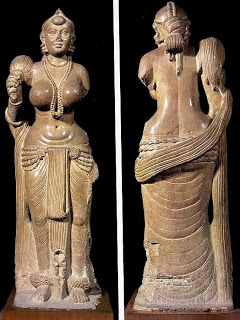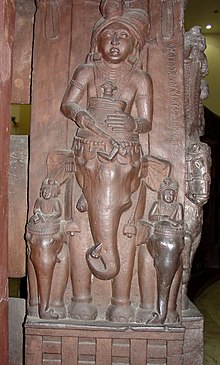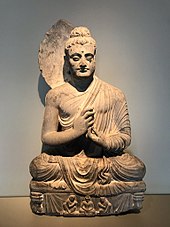Sculpture is a form of fine arts. This is a three-dimensional art. In this, a three-dimensional shape of living beings is given by soil, stone etc.
Ancient Indian sculpture
Although stone pots and tools were started in stone age, sculpture was developed in India only during Harappan period. From the sites of the Indus Valley Civilization, the statue of Pashupatinath has been received, around which elephants, bulls, deer are. Here a statue of a woman has been received which is wearing a lingerie. It is believed to be the idol of Mother Goddess. From here, a 7-inch long statue of a human head has also been painted. The idols obtained here are of clay, bronze and terikota. Here the bronze statue of the dancer has been received. Apart from this, the seals have been embellished like statues.
Idol worship was not practiced during the Vedic period. People used to worship only around the fire. However some of the idols are mentioned in Vedic literature. With the development of Buddhist, Jain and the present Hindu religion, sculpture too has grown quite.
Mauryan period
There was a lot of development in the sculpture during the Mauryan period. Although there is not much remains of the Mauryan period today. The statue of Ashoka in the Saranath column of Ashoka is the national symbol of India. There are four lions in four directions. Below are Ashoka Chakra Idols of Gautam Buddha and Mahavir Jain were formed during the Maurya period. The statue of Maurya-era has been kept in Patna Museum.
Didarganj Yakshi
The idol of Deedarganj Yakshi is an excellent example of Mauryan sculpture. It was discovered by residents of Deirdarganj. It has been kept in Patna Museum.

The Didarganj Yakshi is a fine specimen of Mauryan art. Almost 2000 years old, it stands five feet four inches and is carved out of a single stone. It is an exquisite carving and almost true to life. Government of India, has used her figure as a fine art ambassador and she has travelled to many countries, including the Smithsonian Institution and the National Gallery of Art, Washington, D.C., USA.
Pre GUPTA Era
Sculpture was at its peak during the Shung era. Pushyamitra Shung created a stupa in which the effect of the sculpture of the Shunga period is seen. Statue art was also developed in the Satavahan dynasty. Satavahana was a Brahmin, but he encouraged Buddhism. Therefore, the development of the statues of Gautam Buddha was also this period. Gandhara style of art was developed in the Kushan period.

Gandhara style
Gandhara style was developed in Kushan period. The art school of Gandhara was world famous, it was built and developed during Kushan period. The most outstanding example of this sculpture is shown in the form of a Buddha as a yogi. Figures related to the life of Gautam Buddha are the best examples of this genre. Idols of Bodhisattva were also made in it.

Mathura style
In the Kushan period, Mathura School was also the head of the Gandhara School. In Mathura style, idols related to Hinduism, Jainism and Buddhism were prominent. Red-white stones have been used in this. This style remained dominant for 1,500 years from the 3rd century BC to the twelfth century. Examples of these are present in Mathura, Varanasi, Prayagraj.
Major examples of ancient Indian sculpture
- Deedarangi Yokshi (Mauryan period)
- Nataraja (Chola period)
- Mother Goddess (Indus Valley Civilization)
- Pashupatinath (Indus valley civilization)
- Shiva Murthy (Kailash Temple, Ellora-Rashtrakutk period)
- Jaisalmer Jain statues of Jaisalmer (Rajput era)
- Statues of the Hoysalaeshwar Temple (Hoysal Dynasty)
- Statues of the Khajuraho Temple (Chandel Dynasty)
- Statues of Sun Temple of Konark (Gang Dynasty)
Gupt period sculpture
Most of the sculpture was developed in the Gupt period. In this period the present form of Hinduism has developed. Hindu deities-idols of gods were prominent in this period. Buddha statue sitting in Sarnath, statue of Buddha standing in Mathura and Buddha statue of Kanti of Sultanganj are the major idols of this period. In this period, Shiva's Ekamukta and Chaturmukhi Shivaling was developed. The development of Ardhanarishwar Murthy also happened during this period. The statue of Lord Harihar from this period has been received from Madhya Pradesh. Apart from this, many other idols of this period have also been received. Buddha statue of Sarnath, statue of Vardhaman Mahavir of Mathura, Varah Murthi of Vidisha, idol of Govardhan Dhari Krishna of Kashi, idol of Vishnu, the Balashshai of Jhansi, is of this age.
Caves of Elephanta
Elephanta caves are located in Mumbai of Maharashtra. They were built during the Rashtrakutra kings. There are seven caves in it. Among them, Shiva's idol is very famous.
Gupta Era Sculpture
Many Gautam Buddha statues have been found in the Vardhan period. Sculpture was also developed in Rajput era. The temple of Khajuraho was built by Chandel Vansi Rajput kings. There is an outstanding example of sculpture in it. Pallavavanshi is also an exemplary example of sculpture in temples of Cholwanshi kings.
Natraj 's statue
The idol of Natraj is the statue of Lord Shiva. Natraj literally means 'Shiva' in the currency of 'Tandav dance' Natraj's statue is the world famous statue. This is the time of Chola rulers who have been kept in Metropolitan Art Museum, New York City.
Medieval Indian sculpture
In the medieval period, with Islam attacks, Islam came to India. There was no law of idol worship in Islam. In the temples built in Hampi by the rulers of Vijayanagara, very good sculpture of sculpture is seen. Rajput kings also encouraged sculpture.